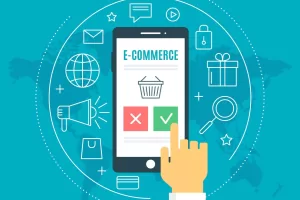E-Commerce Development
- Home
- E-Commerce Development
Our Services
- Android Application Development
- E-commerce Development
- Website Design & Development
- Digital Marketing
- Content Management System
- Responsive Website Development
- Website Maintenance
- Search Engine & Social Media Optimization
- Search Engine & Social Media Marketing
- SMS & EMAIL Marketing
- Graphic Design
- PSD To XHTML
- Software Development
- Network Solutions

E-commerce initiatives can provide reduced costs, increased revenue, and operational efficiencies for businesses that seek an advantage in today’s competitive economic environment. When a buyer views an online catalog and retrieves product or service information, places an order and provides credit and shipping information.
E-commerce transaction may begin. The seller verifies the credit information, processes the order and payment, and schedules fulfillment and shipping.
Today many companies are transitioning from their existing “brochure ware” websites to Web storefronts-sites which expand their functionality to include buying and selling. Some businesses are even integrating sophisticated customer relationship strategies-programs which allow them to confine their site’s content, products and services to their customer’s needs and preferences.
It is usually a good idea to deploy e-commerce capabilities in phases, although a move through the phases is in quick succession. Be sure to consider how an online business can be integrated into existing business strategy and still attracting traffic. The four phases of an e-commerce site are as follows:
• Brochure ware — earlier for the companies “brochure ware” is an E commerce tool. A site will be more effective if it takes advantage of the Internet’s interactive capabilities like using navigated Links to go forth and back through website. Another way to promote business online is to encourage customers to send questions, provide feedback, and inquire about products. These contacts can be turned into valuable leads to complement company’s sales channel, or services online.
• Web Storefront — The Web storefront expands site’s functionality to include online buying and selling which allows a customer to visit a site and purchase goods or services. Web storefronts generate demand, acquire customer information, fulfill orders, and process payment.
• One-to-One Relationships with Customers — Here, customer information -acquired from past interactions-to personalize site’s content, products, and services to the customer’s needs and preferences are used. Internet marketing campaigns also better address customers’ needs. Which can increase customer satisfaction and retention and result in higher sales.
• Communities of Interest — Here customer information is used to identify and engage an online community with personalized products and services tailored to the community created. These communities may already be established and accessible through a third-party site-an e-marketplace. An e-marketplace is a Web-based intermediary, who brings together buyers, sellers, and brokers whose trading needs are similar. By ensuring systems and standards mesh with those of the exchange, one can streamline transactions with a multitude of new customers, suppliers, and purchasers.
By choosing business-appropriate e-commerce solutions, internal management processes can be streamlined and internal, external communication can be improved, and businesses can realize following benefits:
• Lower operational costs
• Greater employee productivity
• Improved inventory management
• Close relationships with partners
• Faster responses to evolving markets, competitive pricing, new product rollouts, and changing consumer tastes
• Increased customer loyalty and traffic
• Stronger branding
